For the 2025 school year, there are 4 public schools serving 1,130 students in Shaker Regional School District. This district's average testing ranking is 5/10, which is in the bottom 50% of public schools in New Hampshire.
Public Schools in Shaker Regional School District have an average math proficiency score of 38% (versus the New Hampshire public school average of 41%), and reading proficiency score of 50% (versus the 51% statewide average).
Minority enrollment is 6% of the student body (majority Hispanic), which is less than the New Hampshire public school average of 18% (majority Hispanic).
Overview
This School District
This State (NH)
# Schools
4 Schools
508 Schools
# Students
1,130 Students
165,155 Students
# Teachers
111 Teachers
14,445 Teachers
Student : Teacher Ratio
10:1
10:1
District Rank
Shaker Regional School District, which is ranked within the bottom 50% of all 189 school districts in New Hampshire (based off of combined math and reading proficiency testing data) for the 2021-2022 school year.
The school district's graduation rate of 80-84% has decreased from 85-89% over five school years.
Overall District Rank
#115 out of 189 school districts
(Bottom 50%)
(Bottom 50%)
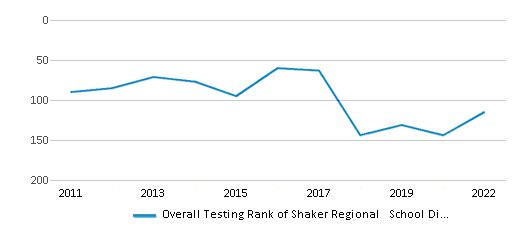
Math Test Scores (% Proficient)
39%
40%
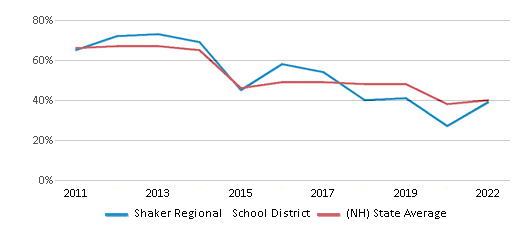
Reading/Language Arts Test Scores (% Proficient)
49%
51%
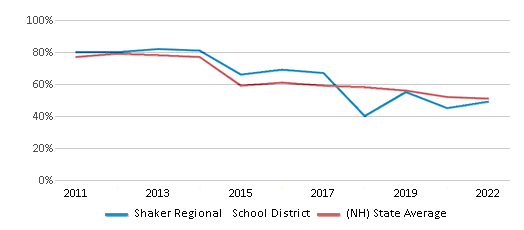
Science Test Scores (% Proficient)
35%
36%

Graduation Rate
80-84%
88%

Students by Ethnicity:
Diversity Score
0.12
0.32
# American Indian Students
n/a
308 Students
% American Indian Students
n/a
n/a
# Asian Students
2 Students
4,993 Students
% Asian Students
n/a
3%
# Hispanic Students
21 Students
12,212 Students
% Hispanic Students
2%
8%
# Black Students
8 Students
3,437 Students
% Black Students
1%
2%
# White Students
1,059 Students
135,947 Students
% White Students
94%
82%
# Hawaiian Students
1 Student
133 Students
% Hawaiian Students
n/a
n/a
# Two or more races Students
39 Students
8,195 Students
% of Two or more races Students
3%
5%
Students by Grade:
# Students in PK Grade:
27
4,442
# Students in K Grade:
81
10,942
# Students in 1st Grade:
76
11,733
# Students in 2nd Grade:
70
12,179
# Students in 3rd Grade:
74
12,078
# Students in 4th Grade:
93
12,182
# Students in 5th Grade:
88
12,522
# Students in 6th Grade:
85
11,957
# Students in 7th Grade:
85
12,326
# Students in 8th Grade:
87
12,086
# Students in 9th Grade:
101
13,698
# Students in 10th Grade:
85
13,269
# Students in 11th Grade:
97
13,028
# Students in 12th Grade:
81
12,713
# Ungraded Students:
-
-
District Revenue and Spending
The revenue/student of $22,375 is higher than the state median of $22,075. The school district revenue/student has grown by 5% over four school years.
The school district's spending/student of $21,165 is less than the state median of $21,293. The school district spending/student has grown by 5% over four school years.
Total Revenue
$25 MM
$3,646 MM
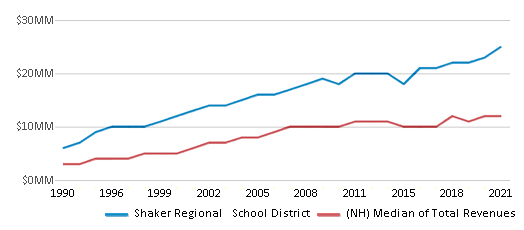
Spending
$24 MM
$3,517 MM
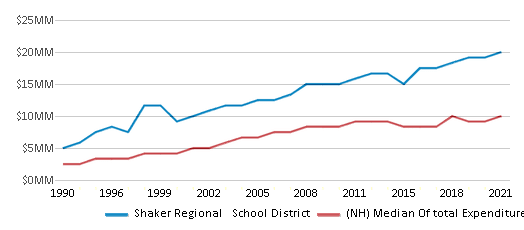
Revenue / Student
$22,375
$22,075

Spending / Student
$21,165
$21,293
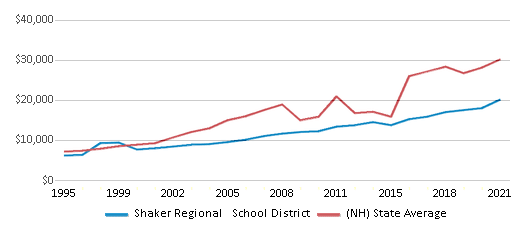
Best Shaker Regional School District Public Schools (2025)
School
(Math and Reading Proficiency)
(Math and Reading Proficiency)
Location
Grades
Students
Rank: #11.
Canterbury Elementary School
(Math: 60-69% | Reading: 60-69%)
Rank:
Rank:
9/
Top 20%10
15 Baptist Rd.
Canterbury, NH 03224
(603) 783-9944
Canterbury, NH 03224
(603) 783-9944
Grades: K-5
| 106 students
Rank: #22.
Belmont High School
(Math: 30-34% | Reading: 55-59%)
Rank:
Rank:
5/
Bottom 50%10
255 Seavey Rd.
Belmont, NH 03220
(603) 267-6525
Belmont, NH 03220
(603) 267-6525
Grades: 9-12
| 364 students
Rank: #33.
Belmont Middle School
(Math: 35% | Reading: 51%)
Rank:
Rank:
5/
Bottom 50%10
38 School St.
Belmont, NH 03220
(603) 267-9220
Belmont, NH 03220
(603) 267-9220
Grades: 5-8
| 329 students
Rank: #44.
Belmont Elementary School
(Math: 35-39% | Reading: 35-39%)
Rank:
Rank:
4/
Bottom 50%10
26 Best St.
Belmont, NH 03220
(603) 267-6568
Belmont, NH 03220
(603) 267-6568
Grades: PK-4
| 331 students
Frequently Asked Questions
How many schools belong to Shaker Regional School District?
Shaker Regional School District manages 4 public schools serving 1,130 students.
What is the rank of Shaker Regional School District?
Shaker Regional School District is ranked #113 out of 189 school districts in New Hampshire (bottom 50%) based off of combined math and reading proficiency testing data for the 2021-2022 school year.
What is the racial composition of students in Shaker Regional School District?
94% of Shaker Regional School District students are White, 3% of students are Two or more races, 2% of students are Hispanic, and 1% of students are Black.
What is the student/teacher ratio of Shaker Regional School District?
Shaker Regional School District has a student/teacher ratio of 10:1, which is lower than the New Hampshire state average of 11:1.
What is Shaker Regional School District's spending/student ratio?
The school district's spending/student of $21,165 is less than the state median of $21,293. The school district spending/student has grown by 5% over four school years.
Recent Articles

Year-Round Or Traditional Schedule?
Which is more appropriate for your child? A year-round attendance schedule or traditional schedule? We look at the pros and cons.

Why You Should Encourage Your Child to Join a Sports Team
Participating in team sports has a great many benefits for children, there is no doubt. In this article you will learn what those benefits are.

White Students are Now the Minority in U.S. Public Schools
Increasing birth rates among immigrant families from Asia and Central and South America, combined with lower birth rates among white families, means that for the first time in history, public school students in the United States are majority-minority. This shift in demographics poses difficulties for schools as they work to accommodate children of varying language abilities and socio-economic backgrounds.





